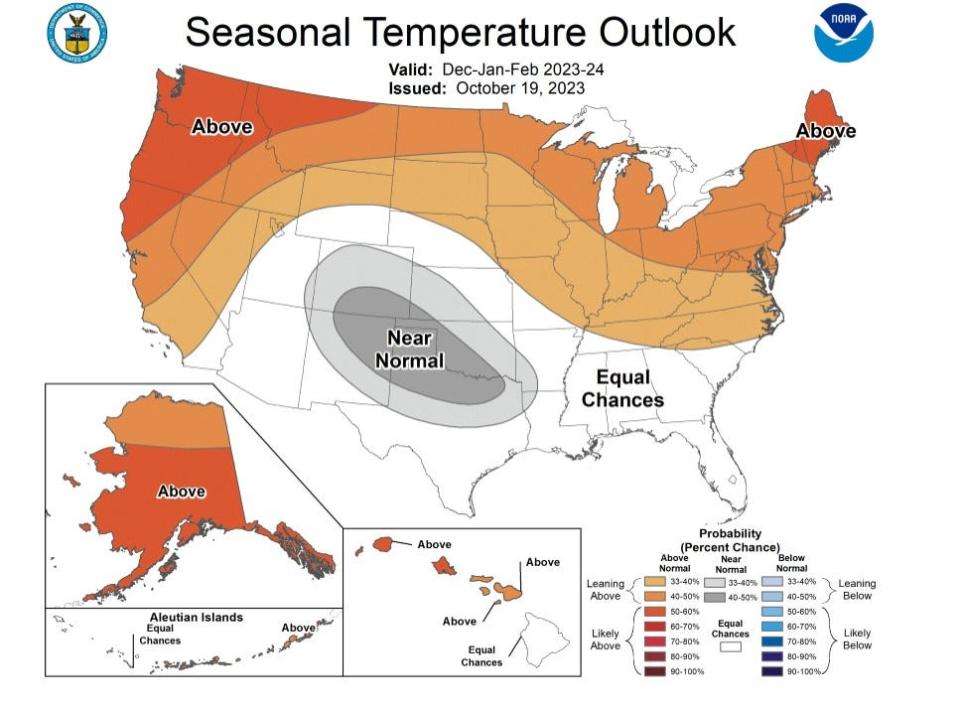NOAA releases winter weather prediction for Rhode Island. What to know.
Southern New England is likely to have a warmer and wetter winter than normal, according to the National Oceanic and Atmospheric Administration's winter outlook.
For the Providence area, that means the average temperature in December would exceed the normal average temperature of 35.5 degrees, while January and February would exceed the normal average temperatures of 30.2 degrees and 32 degrees respectively.
More: Nor'easter to 'wallop' Southern New England this weekend. What to expect.

What does that mean for snowstorms?
The Providence area normally gets slightly more than 12 inches of rain and 28.4 inches of snow in December, January and February, according to the weather service. The outlook, released Thursday, doesn't forecast snowfall, since snow forecasts generally aren't reliable more than a week in advance, NOAA said.
The outlook covers the three months of meteorological winter, December, January and February. It forecasts whether temperatures are likely to be at, below or above normal. It's produced by the Climate Prediction Center – a division of NOAA's National Weather Service.
Did you miss snow last winter? Here's what the Farmers' Almanac is predicting this year
What is El Niño?
NOAA bases much of its outlook on climate patterns in the Pacific Ocean, detectable in water temperature and the strength of trade winds. The patterns affect weather around the world, according to NOAA. First noticed by South American fishermen in the 1600s, the opposing patterns carry Spanish names and this year, an El Niño pattern is in place heading into winter for the first time in four years, NOAA said.
During El Niño, the westerly trade winds weaken and warm water is pushed back east, toward the west coast of the Americas, according to NOAA.
More: Nor'easter to 'wallop' Southern New England this weekend. What to expect.
"El Niño can affect our weather significantly," NOAA says on its website. "The warmer waters cause the Pacific jet stream to move south of its neutral position. With this shift, areas in the northern U.S. and Canada are dryer and warmer than usual. But in the U.S. Gulf Coast and Southeast, these periods are wetter than usual and have increased flooding."
This year's outlook says "warmer-than-average temperatures are favored across the northern tier of the U.S. and much of the Far West. The greatest odds for warmer-than-average conditions are in Alaska, the Pacific Northwest and northern New England."
Southern New England is "leaning above" normal with a 40% to 50% chance of above-normal temperatures this winter, according to NOAA.
For precipitation, Southern New England is also "leaning above" normal with a 33% to 40% chance of having a wetter-than-normal winter, NOAA says.
Rain may ruin vacations but help with drought
New Englanders who head south during the winter might like to know that the Southeast, including Florida, is among the areas most likely to have a wetter-than-average winter.
More: Rhode Island's summer of extreme weather left its mark on the landscape, and people's minds
Southern New England isn't in a drought, but a rainy winter could help other parts of the country.
“According to the Oct. 17 U.S. Drought Monitor, a third of the country, including Puerto Rico, is in drought,” said Brad Pugh, operational drought lead with NOAA’s Climate Prediction Center.“ During late October, heavy precipitation is likely to result in drought improvement for the central U.S. El Nino with its enhanced precipitation is expected to provide drought relief to the southern U.S. during the next few months.”
The outlook will be updated Nov. 16.
This article originally appeared on The Providence Journal: How cold will it get in Rhode Island this winter? What NOAA says

